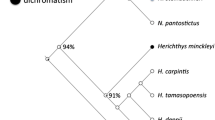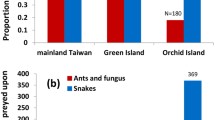Summary
Long-billed curlews (Numenius americanus) appear unique among scolopacid shorebirds so far studied in possessing a significant sex bias in natal philopatry. We resighted 9 curlews at least attempting to breed that were color-banded as chicks; 8 of these were males. Male curlews also cooperate extensively with neighbors in mobbing potential chick predators. This mutualistic behavior may have evolved through kin selection among philopatric males. If so, we would expect such an evolutionary consequence to lead to a similar sex bias in breeding area fidelity. Yet our resightings of colorbanded adults over 4 consecutive years indicate that males and females were equally likely to return to previous nesting territories. Excessive disturbance such as capture and nest loss within a single breeding season was correlated with the likelihood of breeding dispersal by females but not males. This suggests potentially stronger breeding area fidelity of males.
Similar content being viewed by others
References
Baker MC, Marler P (1980) Behavioral adaptations that constrain the gene pool in vertebrates. In: Markl H (ed) Evolution of social behavior: Hypotheses and empirical tests. Verlag Chemie, Weinheim
Boyd H (1962) Mortality and fertility of European Charadrii. Ibis 104:368–387
Greenwood PJ (1980) Mating systems, philopatry, and dispersal in birds and mammals. Anim Behav 28:1140–1162
Johnsgard PA (1981) The plovers, sandpipers, and snipes of the world. University of Nebraska Press, Lincoln, Nebraska
Johnson DH (1979) Estimating nest success: the Mayfield method and an alternative. Auk 96:651–661
Mayfield HF (1975) Suggestions for calculating nest success. Wilson Bull 87:456–466
Oring LW, Lank DB (1982) Sexual selection, arrival times, philopatry, and site fidelity in the polyandrous spotted sandpiper. Behav Ecol Sociobiol 10:185–191
Pitelka FA, Holmes RT, MacLean SF Jr (1974) Ecology and evolution of social organization in arctic sandpipers. Am Zool 14:185–204
Redmond RL, Bicak TK, Jenni DA (1981) An evaluation of breeding season census techniques for long-billed curlews (Numenius americanus). Stud Avian Biol 6:197–201
Shields WM (1982) Optimal inbreeding and the evolution of philopatry. In: Swingland IR, Greenwood PJ (eds) The ecology of animal movement. Oxford University Press, London
Simmons KEL (1955) The nature of the predator-reactions of waders towards humans; with special reference to the role of the aggressive, escape, and brooding drives. Behavior 8:130–173
Sokal RR, Rohlf FJ (1981) Biometry, 2nd ed. Freeman, San Francisco
Sordahl TA (1981) Predator mobbing behavior in the shorebirds of North America. Wader Study Group Bull 31:41–44
Author information
Authors and Affiliations
Rights and permissions
About this article
Cite this article
Redmond, R.L., Jenni, D.A. Natal philopatry and breeding area fidelity of long-billed curlews (Numenius americanus): Patterns and evolutionary consequences. Behav Ecol Sociobiol 10, 277–279 (1982). https://doi.org/10.1007/BF00302817
Received:
Accepted:
Issue Date:
DOI: https://doi.org/10.1007/BF00302817




